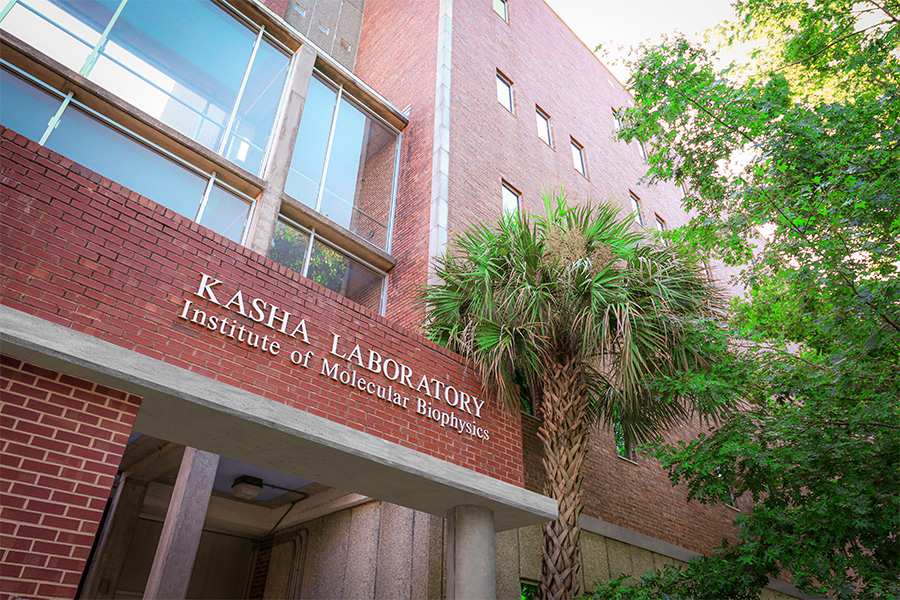
The Institute of Molecular Biophysics (IMB) at Florida State University is located in the Kasha Laboratory Building, named for one of the founders of the Institute, Michael Kasha, Ph.D. IMB has a long history as a unique interdisciplinary research unit dedicated to the application of physical and chemical principles to the investigation of biological phenomena.
The Institute is the home for the Molecular Biophysics (MOB) Graduate Program, a unique doctoral program for students interested in cutting edge research where exploration into the molecular basis for biological phenomenon meets modern biophysical methodologies. MOB faculty members are found throughout the campus, with home departments in chemistry and biochemistry, biological science, mathematics and biomedical engineering. The interdisciplinary nature of the MOB program, with its flexible curriculum and tailored research training, sets it aside from other programs housed in specific departments.
Research Focus
Biophysics research at Florida State University includes over 35 research groups. Nine groups, four core facilities and the Molecular Biophysics Graduate Program call the Institute’s Kasha Laboratory their home, while others are located in the associated Departments of Biological Science, Chemical and Biomedical Engineering, Chemistry and Biochemistry, Mathematics and Physics.
Researchers work together to solve problems that have direct biomedical applications, such as the design of new therapeutic agents. Researchers at the Institute have a broad range of interests, including structural biology, systems and computational biophysics, and the biophysics of neurons and neural systems.
Efforts in structural biology include investigations into the folding of proteins, assembly into larger structures, examining stability and dynamics, and characterizing these properties in model systems. Challenging frontier areas include characterizations of the interactions between proteins and membranes, sugars or nucleic acids. Most of the research is fundamental, leading to future biomedical advances. However, some applications are more immediate, such as improving inhibitors of proteases involved in cancer metastasis.
Systems and computational biophysics research involves efforts to gain an understanding of how complex systems of interactions between biomolecules or cells lead to biological function or dysfunction. Some topics of investigation include the coordination of oscillations among insulin-secreting pancreatic islets, oscillations in genetic regulatory networks, and the cellular basis of neurodegenerative disease.
Another focus of Institute researchers is neuroscience. In particular, there is a focus on chemical sensing, which refers to the neural mechanisms underlying the sense of smell and taste. There are ongoing collaborations on these topics that combine experimental investigations with mathematical modeling and the development of novel data analysis techniques.
Progress in these research areas often goes hand-in-hand with technological development. Studies of biomolecules are facilitated by close association with the National High Magnetic Field Laboratory, where we utilize magnetic resonance and mass spectrometry to analyze structure and dynamics. Other in-house techniques include cryo-electron microscopy, x-ray crystallography, and computer simulation. FSU is home to one of the world’s most advanced robotic electron microscopes, the FEI Titan Krios. A university-wide shared High Performance Computing Facility with nearly 7,000 cores and advanced visualization capabilities supports computational research. FSU is also a member of NSLS-II at the Brookhaven National Laboratory, Upton, NY with access to third generation synchrotron beam lines at the world’s second most powerful x-ray source.
The fourth floor of the Institute houses SCUBA, the Systems and Computational Understanding of Biophysical Actions. SCUBA researchers use mathematical and computational approaches to understand questions at the molecular, cellular, and physiological levels. To this end, they have strong collaborations with experimental groups affiliated with the Institute and the MOB graduate program.

